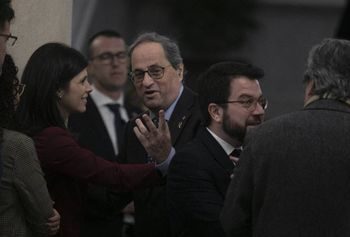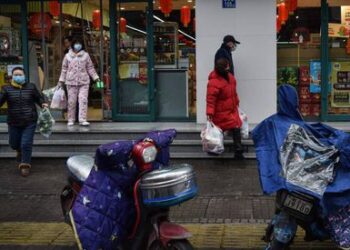
Supporters of independence observed Catalonia Day, known locally as Diada, with a march that organizers meant as a show of force ahead of the upcoming verdict following the trial of secessionist leaders at Spain’s Supreme Court.
Around 600,000 demonstrators, according to the local police, gathered in Barcelona on Wednesday evening on the occasion of the anniversary of the fall of the city in 1714 during the War of Spanish Succession.
They marched under the slogan “Objective: independence,” two years after a failed secession attempt that ended with the temporary suspension of regional self-rule.
While the Catalan premier at the time, Carles Puigdemont, fled Spain with a few aides and settled down in Belgium, other members of his government were arrested and have been held in preventive prison since then. The Supreme Court, which tried 12 leaders of the illegal breakaway attempt in February, is expected to hand down a decision in the first half of October.
Leading members of the march made public statements promising to keep working towards independence, despite the fact that the separatist movement is now politically divided compared with 2017, the year of the unauthorized referendum and unilateral independence declaration.
“Today, we are thousands marching under a very simple slogan: ‘Objective: independence’ and that is our challenge,” said Quim Torra, the Catalan premier, at the end of the march. “Today, a period ends and the response to the ruling begins. We will put the goal of independence at the center of political action.”

“When injustice is the law, civil disobedience is a right, and we will not give up on defending our rights through non-violent struggle in order to change reality and unfair laws,” said Marcel Mauri, vice-president of the pro-independence association Omnium.
A new consensus
Earlier in the day, the rain did not prevent the traditional offering of flowers at the foot of the statue of Rafael Casanova, a hero of the 1714 Siege of Barcelona.
Lowest turnout
The Barcelona municipal police estimated attendance at 600,000 people, which would make this the smallest Diada march since 2012, when these demonstrations began to gain traction as part of the independence drive. The biggest one was in 2014 with 1.8 million protesters, using figures from the same source.
The speaker of the Catalan parliament, Roger Torrent, underscored that his predecessor Carme Forcadell remains in preventive custody while awaiting the Supreme Court decision. “We are part of another exceptional Diada due to the existence of political prisoners” he said.
Torrent, of the Catalan Republican Party (ERC), thinks that the upcoming court ruling will open up a new political cycle in which it will be necessary to “build broad majorities, which exist in this country, who say they don’t want repression, that they want a democratic society and who share a republican agenda.”
The Catalan Socialist Party (PSC) and Units per Avançar (United to Move Forward) were the only non-separatist parties to take part in the flower ceremony, where they asked for a “new consensus” to bridge the divide between Catalans who are pro and against independence.
Other non-nationalist parties made statements along those lines.
Hartos de que el separatismo nos excluya de una fiesta que debería ser de todos. Cansados de que Torra y su gobierno hable en nombre de todos los catalanes. Ni la #Diada ni Cataluña es solo de aquellos que quieren separarnos del resto de España. Avui i sempre #CataluñaSomosTodos pic.twitter.com/LHcAoxnlsT
— Laura Vílchez (@LauraVilchezS) September 11, 2019
“Tired of being excluded by separatists from a celebration that should belong to everyone. Tired of hearing [Catalonia’s separatist premier] Torra and his government speaking in the name of all Catalans. Neither the Diada nor Catalonia belong just to those who want to separate us from the rest of Spain,” tweeted Laura Vílchez of Ciudadanos.
English version by Susana Urra.
Get real time update about this post categories directly on your device, subscribe now.





















